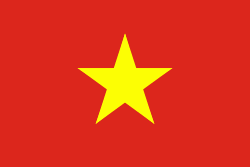Ba Đình District (Quận Ba Đình)
Ba Đình is one of the four original urban districts (quận) of Hanoi, the capital city of Vietnam. The district currently has 14 wards, covering a total area of 9.21 square kilometers. As of 2019, there were 221,893 people residing in the district, the population density is 24,000 inhabitants per square kilometer.
Ba Đình district has a large number of monuments, landmarks and relics, including Ho Chi Minh Mausoleum, One Pillar Pagoda, Flag Tower of Hanoi and Imperial Citadel of Thăng Long, a UNESCO World Heritage Site.
Ba Đình is the political center of Vietnam. Most of the government offices and embassies are located here. It was formerly called the "French Quarter" (Khu phố Pháp) because of a high concentration of French-styled villas and government buildings built when Hanoi was the capital of French Indochina. This name is still used in travel literature. The southern half of Hoàn Kiếm district is also called the "French Quarter", also because of numerous French-styled buildings, most of which are now used as foreign embassies.
The wreckage of a B-52 bomber shot down during the Vietnam War can be seen in Hữu Tiệp Lake in the Ngọc Hà neighborhood.
One of the oldest remaining structures in the neighborhood is the One Pillar Pagoda, built under the Lý dynasty. In 1901, the Presidential Palace was built. On September 2, 1945, Ho Chi Minh read the Declaration of Independence at Ba Dinh Square to approximately 500,000 people. Following his death in 1969, the preserved body of Ho Chi Minh was put on display in the Hồ Chí Minh Mausoleum, located in Ba Dinh Square, in 1975.
Ba Đình district has a large number of monuments, landmarks and relics, including Ho Chi Minh Mausoleum, One Pillar Pagoda, Flag Tower of Hanoi and Imperial Citadel of Thăng Long, a UNESCO World Heritage Site.
Ba Đình is the political center of Vietnam. Most of the government offices and embassies are located here. It was formerly called the "French Quarter" (Khu phố Pháp) because of a high concentration of French-styled villas and government buildings built when Hanoi was the capital of French Indochina. This name is still used in travel literature. The southern half of Hoàn Kiếm district is also called the "French Quarter", also because of numerous French-styled buildings, most of which are now used as foreign embassies.
The wreckage of a B-52 bomber shot down during the Vietnam War can be seen in Hữu Tiệp Lake in the Ngọc Hà neighborhood.
One of the oldest remaining structures in the neighborhood is the One Pillar Pagoda, built under the Lý dynasty. In 1901, the Presidential Palace was built. On September 2, 1945, Ho Chi Minh read the Declaration of Independence at Ba Dinh Square to approximately 500,000 people. Following his death in 1969, the preserved body of Ho Chi Minh was put on display in the Hồ Chí Minh Mausoleum, located in Ba Dinh Square, in 1975.
Map - Ba Đình District (Quận Ba Đình)
Map
Country - Vietnam
 |
 |
| Flag of Vietnam | |
Vietnam was inhabited by the Paleolithic age, with states established in the first millennium BC on the Red River Delta in modern-day northern Vietnam. The Han dynasty annexed Northern and Central Vietnam under Chinese rule from 111 BC, until the first dynasty emerged in 939. Successive monarchical dynasties absorbed Chinese influences through Confucianism and Buddhism, and expanded southward to the Mekong Delta, conquering Champa. The Nguyễn—the last imperial dynasty—surrendered to France in 1883. Following the August Revolution, the nationalist Viet Minh under the leadership of communist revolutionary Ho Chi Minh proclaimed independence from France in 1945.
Currency / Language
| ISO | Currency | Symbol | Significant figures |
|---|---|---|---|
| VND | Vietnamese đồng | ₫ | 0 |
| ISO | Language |
|---|---|
| KM | Central Khmer language |
| ZH | Chinese language |
| EN | English language |
| FR | French language |
| VI | Vietnamese language |















